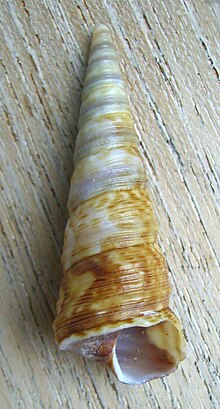Cerithioidea
| Cerithioidea Temporal range: Triassic–Recent |
|
|---|---|
 |
|
| A live individual of Terebralia palustris, family Potamididae | |
 |
|
| A beachworn shell of Maoricolpus roseus, family Turritellidae. Most of the body whorl has been broken off in this specimen, possibly by a predator such as a crab. | |
| Scientific classification | |
| Kingdom: | Animalia |
| Phylum: | Mollusca |
| Class: | Gastropoda |
| (unranked): |
clade Caenogastropoda clade Sorbeoconcha |
| Superfamily: |
Cerithioidea Fleming, 1822 |
| Diversity | |
|
1092-1164 extant species about 200 extant genera |
|
clade Sorbeoconcha
about 200 extant genera
17 extant families
The Cerithioidea is a superfamily of marine, brackish water and freshwater gastropod containing more than 200 genera. The Cerithoidea are included in the clade Sorbeoconcha. The original name of this superfamily was Cerithiacea, in keeping with common superfamily endings at the time.
Cerithioidea is a very diverse superfamily. Its species can be found worldwide mainly in tropic and subtropic seas on rocky intertidal shores, seagrass beds and algal fronds, but also in estuarine and freshwater habitats. The freshwater species are found on all continents, except Antarctica. They are dominant members of mangrove forests, estuarine mudflats, fast-flowing rivers and placid lakes.
Their fossil record of this superfamily can be traced back as far as the early Triassic but they began radiating mainly during the Cretaceous.
The Cerithioidea are presumed to be monophyletic (one lineage). However the phylogenetic relationships between its families are still under investigation because recombinant DNA sequences failed to resolve these questions.
According to the Taxonomy of the Gastropoda (Bouchet & Rocroi, 2005), the following families are included in Cerithioidea:
(Extinct taxa indicated by a dagger, †.)
...
Wikipedia
